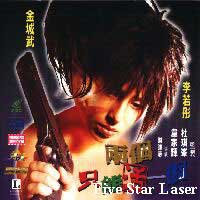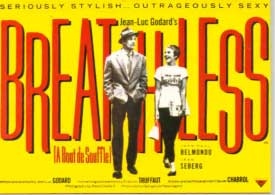


It feels as if it is trying so hard to be hip and avant-garde that in the process it becomes tedious and highly pretentious. It is directed by Patrick Yau who seems to have spent way too much time prostrating to his shrine of Wong Kar Wai. Unfortunately, he only learned how to fake it like a prostitute and gives the film no true emotional heart. Think of the most vapid French New Wave film you have seen and you will get an idea of this effort. Apparently, having everything in cool neon red reflected lights, abstract camera angles, minimalist dialogue, actors with sulky looks and nihilistic attitudes and cigarettes dangling listlessly from their lips is enough to hang this film on.
Takeshi Kaneshiro with cutsie bangs covering his face and Carman Lee having darker shadows underneath her dead eyes than Bela Lugosi with a hangover for much of the film are two wanna be killers. Who knows why, who knows why they are hired, who really cares anyway. We do get to see Takeshi run around HK a lot and someone has his fingers cut off a few times (this passes for humor in this film), but to absolutely no point. Many events are repeated over such as trying to register in a hotel or the before mentioned cutting off of fingers but the profundity of this escaped me.

As I mentioned before the two main actors are quite lovely - which is prettier is debatable - and often the film feels more like a fashion shoot with them posing in cool repose than a film. Takeshi utilizes his soulful eyes to great effect and once Carman takes a bath she too is a treat for the eyes - bad haircut and all.
The film has a very catchy cha cha cha tune that plays throughout and in the final fifteen minutes the film begins to finally show some heart as opposed to strictly style and the two characters do begin to matter - but it is a while getting there. If you want to see a film about two killers on the run and in love - I would recommend watching Godard's Breathless instead.

My rating for this film: 5.0

For the record: This Patrick Yau helmed offering -- which (ostensibly) centers on a pair of oddballs and (initially) seems to make light of their seeking to earn lots of money by carrying out the task of killing a man with whom they have had no prior contact -- would not make my 1997 Top Ten Hong Kong movies list (that would, instead, include the likes of Patrick Leung’s “Task Force”, Fruit Chan’s “Made in Hong Kong”, Wong Kar Wai’s “Happy Together”, Ringo Lam’s “Full Alert”, Joe Ma’s “First Love Unlimited” and Yang Feng Liang’s criminally overlooked “Dragon Town Story”). This is not least because I don’t believe that its makers are entirely successful at accomplishing what they set out to do with this effort. At the same time however, I (too) can indeed see that this early Milkyway Image work is not without its particular charms -- notably that which were supplied by a music composer (Raymond Wong) and cinematographer (Cheng Siu Keung) whose reputations have risen over the years, in tandem with the Johnnie To headed film company with which they have become regularly associated, as well as a couple of young stars (Takeshi Kaneshiro and Carmen Lee) who do not seem to have made as big a name for themselves in Hong Kong as their talents deserve.

Still, this is not to say that there’s no possibility
of this jaunty cha cha cha music enlivened Johnnie To and Wai Ka Fai co-production
(also) containing certain condemnatory messages about those of Hong Kong’s
capitalistic and materialistic tendencies that are anti-social and can de-humanize
the territory’s inhabitants). Put another way: It’s difficult to behold
such a scene that’s contained in THE ODD ONE DIES, in which the effort’s
main character -- angrily attempts to literally flush money down the toilet
(or another in which he’s illogically prepared to pretty much gamble all
he owns on one hardly sure bet), and not think that there is “a substantive
subtext that skewers HK’s obsession with big wads of cash” (See Stefan Hammond’s
“Hollywood East: Hong Kong Movies and the People Who Make Them”, 2000:29).
And this even when the individual concerned is as much of a grungy loser
type plus societal misfit as the doe-eyed Takeshi Kaneshiro can portray.

For all of this though, THE ODD ONE DIES looks to want to be a work that seeks to ultimately encourage the cultivation of hope rather than despair or even just plain resignation. In contrast to an older character’s pessimistic suggestion that “We (are destined to) keep on repeating the same thing”, Mo’s actions -- and the way in which certain segments of the film (that prove to be more than mere running gags) play out -- appear to point to there in fact being lights at the end of the darkest looking tunnels plus ways to escape out of seemingly dead-end situations. Relatedly, the movie’s makers seem to want to encourage the thought that: Even when matters seem pretty bleak, one can still make a determined effort to enjoy whatever little and big luxuries that life is liable to continue to offer up, some upbeat music, interesting sights, and the (HK$2 only tram) ride.
My rating for the film: 7.